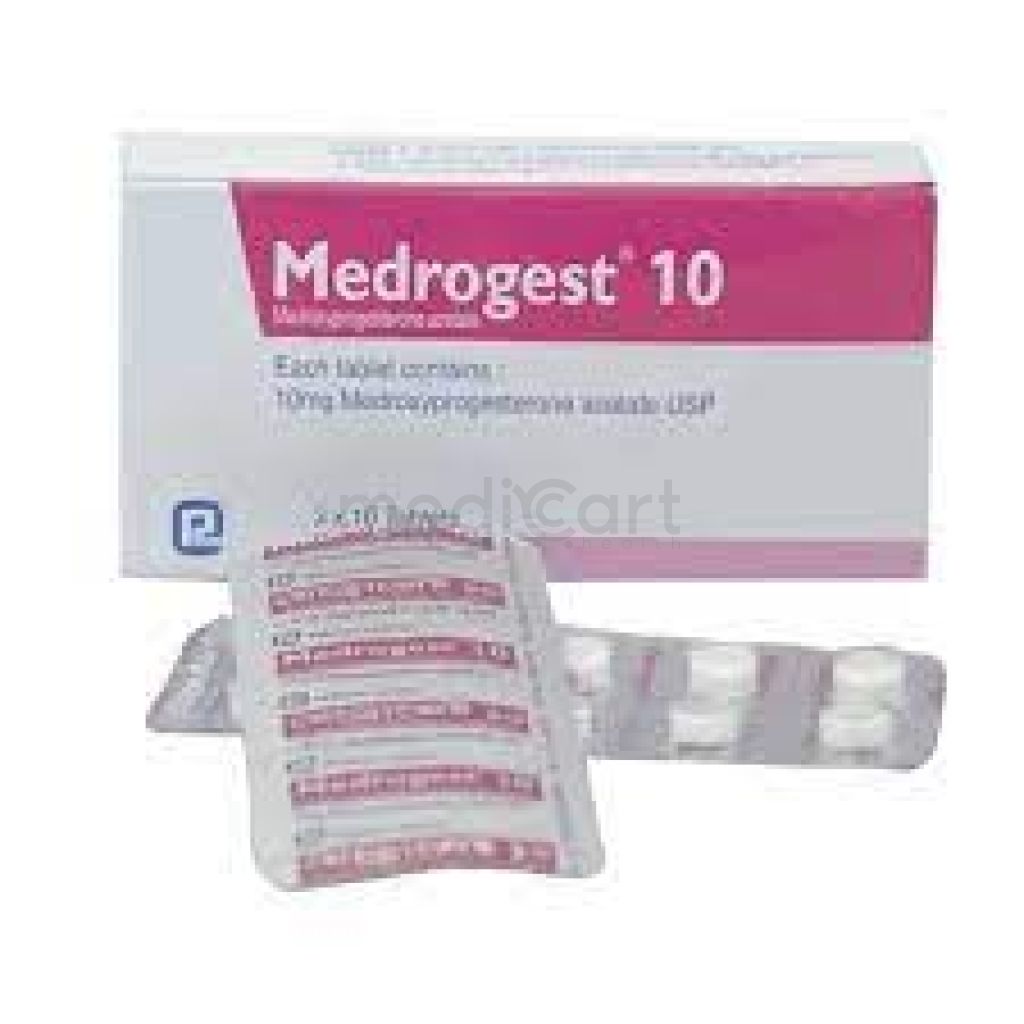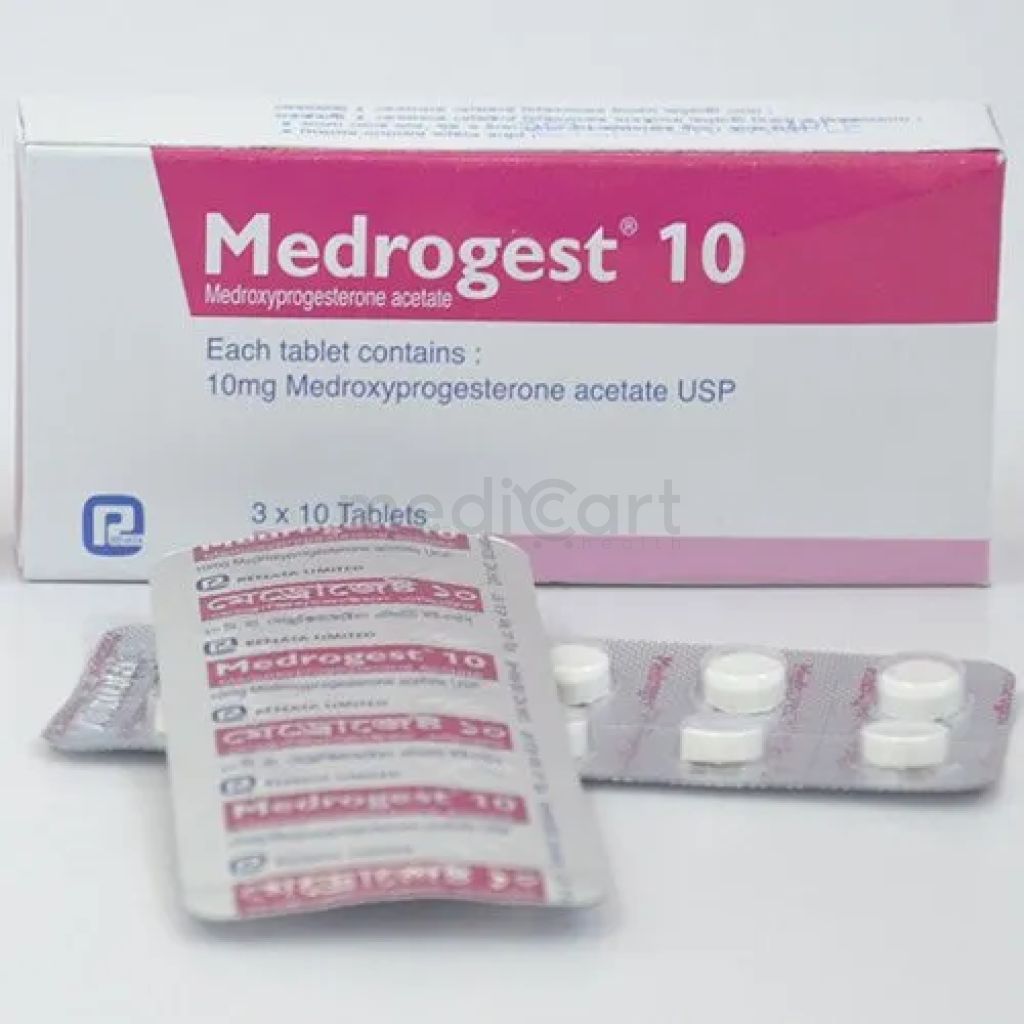

Medrogest 10 mg Tab. 10mg
Tablet
Pack Size :
10 Tablet x 1 Stripe
Generics :
Medroxyprogesterone Acetate
Manufacturer :
Renata Limited
Best Price *
TK
100.00
* Delivery will be done in Dhaka city only.
More Information About - Medrogest 10 mg Tab. 10mg
Description
Generic Name
Medroxyprogesterone AcetatePrecaution
Breakthrough bleeding is likely to occur in patients being treated for endometriosis. May cause some degree of fluid retention, conditions which might be influenced by this factor, such as epilepsy, migraine, asthma, or cardiac or renal dysfunction, require careful observation. A decrease in glucose tolerance has been observed in some patients. Patients with depression, DM, epilepsy, asthma, migraine, hypertension, renal or cardiac dysfunction. Monitor patient closely for loss of vision, proptosis, diplopia and thromboembolic disorders. Lactation: SafeIndication
Menorrhagia, endometriosis, secondary amenorrhoea, contraception, abnormal uterine bleeding due to hormonal imbalance in the absence of organic pathologyContra Indication
Thromboembolic disorders; cerebral apoplexy; severe hepatic dysfunction; incomplete abortion, hormone-dependent carcinoma; Undiagnosed vaginal bleeding, Undiagnosed urinary tract bleeding, Known or suspected pregnancy, Undiagnosed breast pathology, Missed abortion, Active thromboembolic disorders, Markedly impaired liver function,Dose
N/ASide Effect
>10% Amenorrhea,Breakthrough bleeding,Change in menstrual flow,Spotting,Edema,Anorexia,Weakness,Pain at injection site Frequency Not Defined Angioedema,Change in weight,Depression,Dizziness,Headache,Nervousness,Somnolence,Breast tenderness,Galactorrhea,Abdominal pain,Nausea and vomiting,Cholestatic jaundice,Deep vein thrombosis (DVT),Thrombophlebitis Potentially Fatal: Thrombophlebitis and pulmonary embolism.Pregnancy Category
Name : Not Classified
Description
FDA has not yet classified the drug into a specified pregnancy category.Mode of Action
Medroxyprogesterone is a synthetic progestogen which converts the proliferative phase of the endometrium into secretory phase. It has some androgenic and anabolic activities but no oestrogenic effects. Parenteral use leads to inhibition of pituitary gonadotropins, thus preventing follicular maturation and ovulation.Interaction
Aminoglutethimide and enzyme-inducing drugs (e.g. carbamazepine, griseofulvin, phenobarbital, rifampicin, phenytoin) may reduce plasma concentrations leading to reduced efficacy. Additional measures required when medroxyprogesterone is used for contraception during coadministration with these drugs.Pregnancy Category Note
Pregnancy Although therapy should not be used during pregnancy, there appears to be little or no increased risk of birth defects in women who have inadvertently been exposed to medroxyprogesterone acetate injections in early pregnancy; neonates exposed to medroxyprogesterone acetate in-utero and followed to adolescence showed no evidence of any adverse effects on their health including their physical, intellectual, sexual or social development Lactation Although the drug is detectable in the milk of mothers receiving therapy, milk composition, quality, and amount are not adversely affected; neonates and infants exposed to medroxyprogesterone acetate from breast milk have been studied for developmental and behavioral effects through puberty, and no adverse effects have been notedAdult Dose
Oral Amenorrhea, Uterine Bleeding Uterine bleeding: 5-10 mg/day PO for 5-10 days; beginning day 16 or 21 of the menstrual cycle; withdrawal bleeding may be expected within 3 to 7 days after discontinuing medroxyprogesterone Amenorrhea, secondary: 5-10 mg/day PO for 5-10 days; may be started at any time; withdrawal bleeding may be expected within 3-7 days after discontinuing medroxyprogesterone Reduction of endometrial hyperplasia: 5 or 10 mg daily for 12 to 14 consecutive days per month, in postmenopausal women receiving daily 0.625 mg conjugated estrogens, either beginning on the 1st day of the cycle or the 16th day of the cycle. Endometriosis: 10 mg three times a day for 90 consecutive days, beginning on the first day of the menstrual cycle Intramuscular Contraception 150 mg deep IM every 3 months The initial injection should be given during the first 5 days after the onset of a normal menstrual period; within 5 days post-partum if not breast-feeding; or if exclusively breast-feeding at or after six weeks post-partum.Child Dose
N/ARenal Dose
N/AAdministration
May be taken with or without food. Incidence of minor indigestion may increase as dose increases. Take w/ meals if necessary.Disclaimer
The information provided herein are for informational purposes only and not intended to be a substitute for professional medical advice, diagnosis, or treatment. Please note that this information should not be treated as a replacement for physical medical consultation or advice. Great effort has been placed to provide accurate and comprehensive data. However, Medicart along with its authors and editors make no representations or warranties and specifically disclaim all liability for any medical information provided on the site. The absence of any information and/or warning to any drug shall not be considered and assumed as an implied assurance of the Company.






